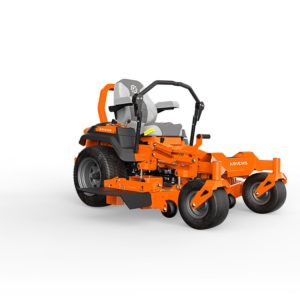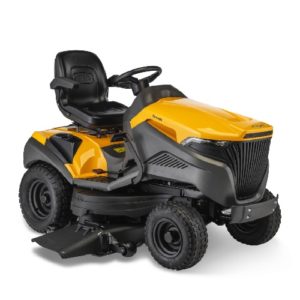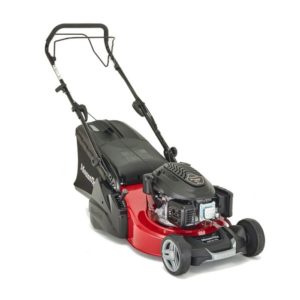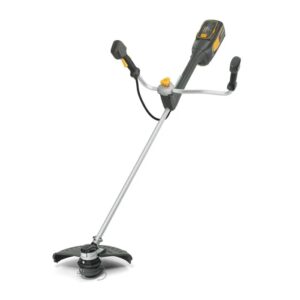WHAT TO BUY & WHY
We understand that buying a lawn mower, like a car, can be a difficult and sometimes confusing decision. What size of cut, what is the difference between models and makes, should I mulch or not (the answer is usually yes if you can)? All sensible questions – and here we hope to provide some answers.
First thing is first – the size of your lawn
Firstly work out how large the area is that you need to cut. That will then help you decide if you need a walk-behind mower or ride-on, front cut or zero turn.
Anything above around half an acre and you’ll likely want a ride-on mower mainly to speed up the process.
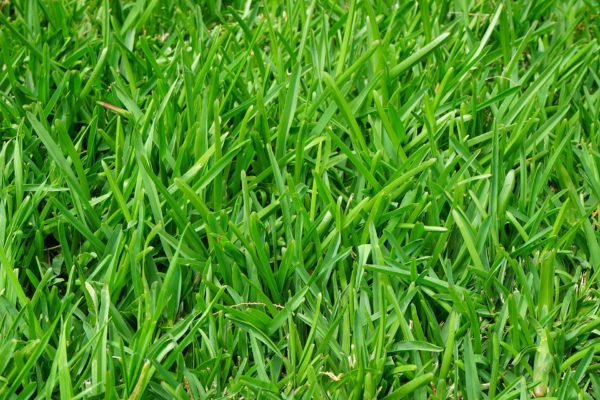
Ride ons, Front Cuts and Zero Turns
Collect or Mulch? Or both?
When buying a ride-on mower you might want to consider if you ever want to collect your grass or if you want to mulch more often than not.
What is Mulching?
Mulching means you don’t collect the grass but it’s finely chopped and the clippings put back into the lawn which acts as a fertiliser. Saving time, hassle and cost in grass feed.
Do you want to collect?
If you want to collect and or mulch then we recommend a collecting mower and purchasing a mulching kit or look at the mowers that come with them already.
If you never want to collect then take a look at our side-discharge models. They put the clippings out the side or mulch with an additional kit and are cheaper than collecting models.


Front Cut and Zero Turn
Front Cut and Zero Turn mowers are great for gardens that have obstacles to get around. If you have a number of trees, or garden features you may want to choose one of these mowers.
4WD drive Front Cut mowers are perfect for gardens with larger slopes and makes cutting far easier in uneven larger gardens.
Zero Turns are very sturdy machines and allow you to turn 360 degrees making getting around obstacles far easier while ensuring a great cut.
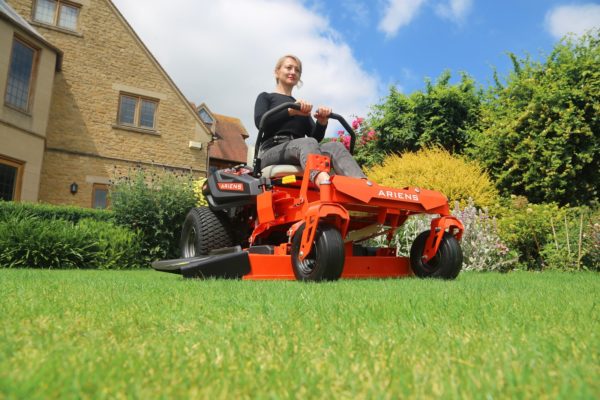
Walk-behinds
Self-Propelled or Hand-Propelled
This is a key difference in any walk-behind that you plan to buy.
A self-propelled walk-behind means that it has transmission and will drive meaning you have less effort when cutting the grass.
A hand-propelled mower means you have to do the pushing. The blades will still be driven off the engine but the wheels won’t drive themselves.
Self-propelled machines are more expensive.
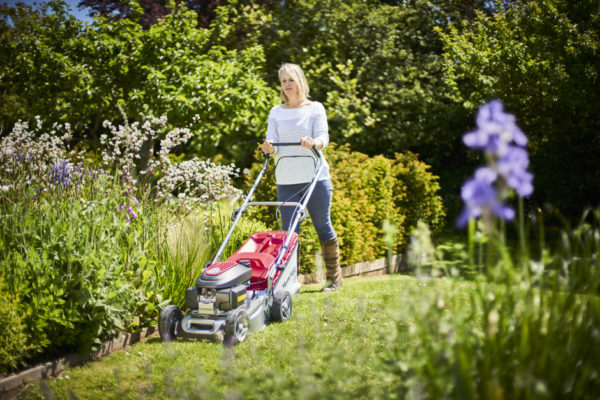
Additional Features
Many walk-behind mowers come with additional features that you may want to consider.
Some will offer mulching and others will also offer side-discharge.
Other machines may have push-start technology.
Once you’ve decided the cutting size of machine and if it drives, then consider the additional features.
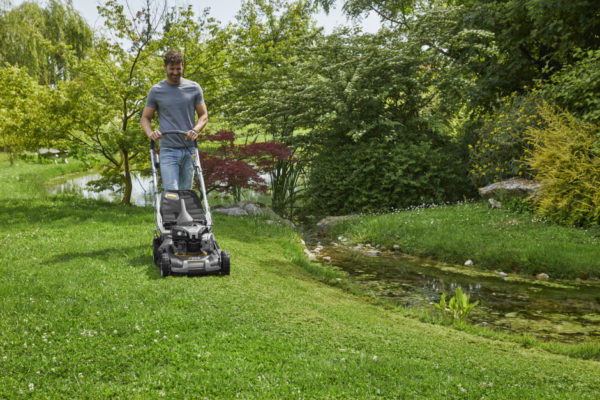
Petrol or battery
Petrol or Battery
We offer both petrol or battery machines. Not just mowers but also for handheld products too.
Battery technology is cleaner, with no fumes and can be quieter too. The initial outlay can be more expensive but can be cheaper in the long run with no fuel costs and often batteries can be used in multiple machines.
Petrol mowers and handheld machines are cheaper to buy in the first instance but they clearly require ongoing fuel costs and are less clean than battery machines.

FAQs
Almost all manufacturers will advise not cutting when the grass is wet. Wet grass usually doesn’t cut as well and can clog up the grass chute causing it to become blocked. It doesn’t leave such a nice finish. We advise waiting until your grass is dry or cutting a stripe to see how your mower is coping.
Like ‘normal’ cutting we don’t advise mulching when the grass is wet. The grass will clump together and rather than being finely chopped back into your lawn, it will leave clumps of grass that can be unsightly. It will also cling to the side of your deck meaning your mower might struggle to cut.
The simple answer to this is yes. If you want to ensure that you mower continues to cut well each time then you need to keep the underside of the deck and blades clean. Rotting grass can be corrosive too, meaning in the long-term it can cause the deck to rust and become fragile. On most ride-on mowers there are ‘wash points’ on deck that allow a garden hose to be attached.
Unlike a car battery most ride-on mower batteries do not generate enough charge when in use to adequately recharge the battery. Therefore, it is necessary to recharge the battery at times. It is important to charge the battery especially over winter or when not in use for long periods of time. Check your manual for recommended maintenance for your ride-on mower battery.
There can be a number of reasons for this, check the following:
- Check that the mulching plug (if your mower has this function) is not in place.
- Check the underside of your mower – clear any grass or debris from the blade and underside of your deck
- Check the grass chute is not blocked
- Check that the grass collector is correctly attached and assembled.
- If your grass collect is a fabric one check for dry grass or debris stuck to the inside. Use a hard bristled brush and give the inside a brush – air needs to circulate through the fibres to maximise grass pick up.
- If grass is very long the amount of grass may be the issue. Try raising the deck and cutting the grass at a higher setting first before lowing the deck and cutting a second time to the desired length.
- If the grass is very wet it may clump and be difficult to collect. Wait for the grass to dry out before cutting.
The most likely cause is your blade boss has sheared off. The blade boss has two metal pins on each side. The pins are designed to shear off and stop the blade from turning and damaging even more to the engine or machine. It will shear if the machine has hit something such as stone. You will need to replace the blade boss. They are inexpensive are far cheaper than doing more damage to your machine.
- If you have a petrol lawnmower, we recommend completely draining the machine of fuel. Petrol starts to go stale after 30 days from purchase and if left in your mower over winter could damage the carburettor and engine causing your mower not to start when you get it out again next year.
- Remove any batteries from your lawnmower and store indoors in a cool, dry place. This includes batteries for quick electric start engines. Remember to charge them regularly to keep them healthy.
- Give it a good clean! Remove any dirt or debris from your mower, paying close attention to the underside of your mower and blade. If left it may be harder to remove this in the new year making your mower less efficient and resulting in an inferior cut. Many modern models have a washing deck link so you can simply attach your garden hose and clean the underside. Avoid using pressure washers on your mower as the high pressure can damage it. Make sure your mower is completely dry once cleaned to avoid rusting.
- If your mower is a petrol model, make sure to store it flat on ground level and not upright or hanging on a wall to avoid oil spilling and flooding the engine.
- Never hang a lawnmower from its handlebars as generally mower handles are not designed to carry the weight of the mower and will bend or break. Most modern models have folding handlebars to help with storage space and some lawnmowers are also designed to be folded down and stored upright or on a wall. Check your manual or with your manufacturer on how to best store your model.
- Lastly make sure the shed or garage you are storing your mower in is dry and leak free. We recommend also covering your lawnmower to help protect it. Lawn mower covers for both walk-behind lawnmowers and garden tractors are available from most lawnmower manufacturers and dealers. You could also use an old blanket or bedsheet if it is clean and dry.
- Do not forget to book your mower in for servicing.
It is important to use ‘fresh’ fuel in any engine and avoid using fuel which is older than 30 days old. This is because modern fuel contains ethanol which absorbs water from the air and contaminates
the fuel causing it to seperate as shown in the picture below.
It can also cause corrosion and blockages in the fueling system resulting in poor engine performance and if left unchecked can damage your engine.
Symptoms of contaminated fuel include –
- Mower will not start
- Rough running
- Engine revs hunting (increasing and decreasing)
- Cutting out
- Universal Fuel Stabiliser is a fuel additive that will keep fuel fresh for easy starting and maximum performance for up to 2 years. If you are likely to keep fuel stored for longer than 30 days, adding this product to your fuel when you purchase it will help to avoid fuel contamination.
E10 fuel is only an issue in your lawnmower if it is left to sit inside the mower or stored for longer than 30 days and allowed to go stale. If you only add the amount of petrol you require and replenish with fresh petrol each time you use your mower, you are unlikely to experience any running issues.
If you want to avoid frequent trips to the petrol station however we recommend adding Mountfield universal fuel stabiliser to freshly purchased petrol. Fuel stabiliser is an additive that will keep your petrol from going stale for up to two years!
If the self-propel on your lawnmower has stopped working this will cause a loss of drive to the mower and is normally due to one of the following reasons:
- The clutch cable has lost tension through either stretching or loss of adjustment.
– check cable adjustment and replace if necessary.
- The clutch cable has broken or has become detached.
– replace clutch drive cable.
- The drive belt has come off the drive pulleys.
– drive belt needs to be refitted
- The drive belt has stretched or broken.
– replace new belt.
- Gearbox failure
– the mower would need to be inspected and replaced.
If you need any help or advice about your lawnmower or garden machine then please get in touch with us.
Visit our Garden Care page for more details on how to look after your mower.

